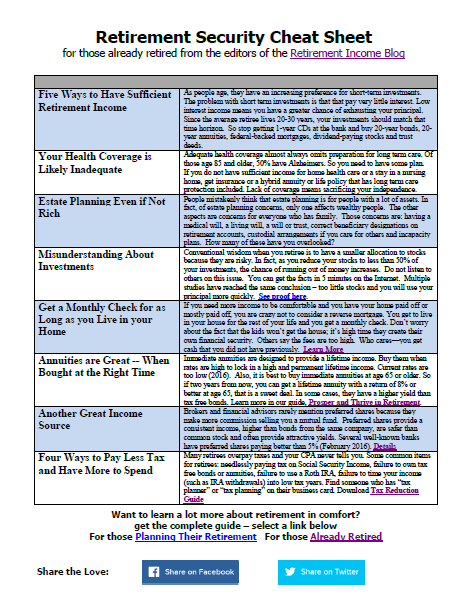Retirees are interested in preserving their retirement funds as long as possible. But because different assets are taxed differently - and yearly where required - the order in which you withdraw income from your retirement funds can significantly affect how fast you'll deplete your wealth. So in what order should you withdraw from which type of assets?
The assets that comprise your retirement fund can generally be broken down as:
- pension income,
- Social Security income,
- savings and investments - composed of taxable investment and tax-deferred investments associated with IRAs, 401(k)s, etc,
- home equity
To maintain your retirement funds as long as possible, the rule is to maximize annual investment growth while minimizing annual taxation of income. Those investments that are tax-deferred - under an equal investment growth scenario - will compound faster than those taxed investments that must forfeit some of their annual earnings to taxes. These latter investments compound more slowly. Therefore, the general rule is to use your tax deferred retirement funds last.
Tax-advantage investments like your home or those subject to capital gains can often present little or no taxation to you. Based on these points, we suggest which assets you may withdraw from first or last to maximize annual growth and minimize taxation. Refer to the table.
Your retirement pension will be taxable as ordinary income and you have no control over those payments once they begin. So that income must be taken as it comes and taxes paid.
Another source of retirement income is your Social Security benefits. This is generally tax free if your other income stays under threshold amounts depending on your filing status; beyond that only 50% of it will be taxed. But try to hold off receiving your benefits until your full retirement age - probably 66 for most of you. You lose some 30% of benefits at 62. Holding off until your 70 will credit you ~30% more in benefits.
Your IRAs and similar tax deferred retirement funds of course grow tax-deferred. This enhances their annual compounding capability. Anything you withdraw from them is taxed at ordinary income rates. So let them ride and withdraw only the required minimum distribution (RMD) amounts starting at age70½.
Roth IRAs compound tax free, have no MRD requirements, and you can withdraw from them tax free. Don't touch them 'til last (or never). They're also the best form of IRA for your beneficiary.
Your taxable retirement funds will have their dividends or interest earnings taxed yearly. Withdraw from these first. Most anything withdrawn beyond the earning will probably be untaxed or taxed at low capital gains rates. Take advantages of any capital losses to offset taxes too. Because of these tax effects, these retirement funds will deplete more slowly than withdrawing from tax-deferred investments.
Use your home equity too. As a tax-advantaged investment, you can sell it and buy down to get at the excess equity at little or no tax since the home sale tax exclusions is $500,000 for a married couple. Or, take a reverse mortgage.


Leave a Reply